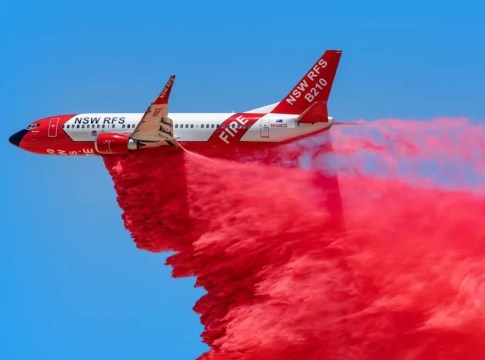The New South Wales Rural Fire Service (NSW RFS) is renowned for its exceptional aerial firefighting capabilities, boasting the largest and most advanced firefighting aircraft fleet in Australia. With a robust combination of owned and contracted aircraft, the NSW RFS aviation unit is a leader in this field both nationally and internationally.
Here’s an in-depth look at the aviation unit of NSW RFS, its history, capabilities, and significant contributions to firefighting and disaster management.
Advertisement:
NSW RFS Aviation Fleet Overview and Capabilities
RFS owns the largest aerial fire-fighting fleet in Australia. The New South Wales Rural Fire Service is recognised as a leader in this field, both nationally and internationally, regularly deploying aircraft and personnel to support partner agencies.
Coulson Aviation Australia manages, operates and maintains the entire NSW RFS owned-fleet which includes 11 aircraft - a 737 large air tanker, two Cessna Citation jet aircraft, six Bell-412 helicopters, a Chinook helicopter, and a Beechcraft Super King Air.

RFS Owned Aircraft
The NSW RFS owns a diverse fleet, including:
Boeing 737 Air Tanker: Known as “Marie Bashir,” this state-owned Large Air Tanker (LAT) is stationed at the Royal Australian Air Force base in Richmond.
It can be deployed to any location within the state in under an hour, providing a swift response to fire emergencies.
Two Citation Jets: Equipped with advanced line scanning and infrared (IR) capabilities, these jets are crucial for fire mapping, monitoring, and flood assessment.
Six Helicopters: This includes the versatile Bell 412 and a Chinook, which enhance the agency’s capacity for water-bombing, reconnaissance, and transportation.
Additional Helicopters: The fleet also comprises BK-117 and Bell 412 helicopters, offering flexibility and increased operational capacity.
Contracted Aircraft
RFS contracts other aircraft for firefighting water-bombing, reconnaissance, intelligence gathering and transportation. The RFS engages additional aircraft through:
Seasonal Contracts via NAFC: Through the National Aerial Firefighting Centre (NAFC), additional aircraft are contracted based on seasonal needs and outlooks.
State-based Call When Needed (CWN) Aircraft: CWN arrangements provide aircraft and aviation fuel services as needed, ensuring a rapid response to emergencies.
Technological Advancements
The NSW RFS continuously upgrades its fleet with the latest technology, including:
Advanced Camera Technology: High-resolution FLIR 380HDc cameras in the Bell 412 and Cessna Citation aircraft enable detailed mapping and real-time data transmission.
Night Vision Capabilities: Enhancements allow for nighttime operations, crucial for intelligence gathering and search and rescue missions.
NSW RFS Aviation Historical Development
The RFS’s aviation capabilities began with the purchase of a second-hand Squirrel helicopter from the NSW Forestry Corporation. This initial acquisition was followed by the addition of two BK-117 helicopters and later, the Bell 412 helicopters.
The fleet expanded significantly with the acquisition of the Boeing 737 Fireliner before the devastating Black Summer fires in 2019/2020.
NSW RFS Aviation Operational Excellence
State Operations Centre
Located at Sydney Olympic Park, the RFS State Operations Centre is an ultra-modern facility that serves as the hub for emergency response coordination. It accommodates liaison officers from various emergency services and government agencies, all working together for a common goal.
The centre features over 100 workstations and a 14-foot wall of screens displaying critical data, including fire and flood maps, weather radar, and news coverage.
Dispatch and Tasking
The RFS State Air Desk is responsible for dispatching aircraft during fire operations. With over 150 trained personnel, the team handles the deployment of aircraft, ensuring a coordinated and efficient response.
During the Black Summer fires, over 130 aircraft were actively tasked on a single day, demonstrating the system’s capability and resilience.
Advanced Prediction and Monitoring Systems
The NSW RFS employs advanced systems like the ARENA software by NAFC for sourcing and tasking aircraft.
The ATHENA system combines GIS data, fire scans, and environmental factors to run 10,000 probabilities of potential fire tracks within two minutes. This powerful AI tool enhances situational awareness and decision-making by overlaying critical information such as vulnerable homes and infrastructure.
NSW RFS Aviation Contributions Beyond Firefighting
Flood Response and Search & Rescue
The multi-role functionality of the RFS aircraft extends beyond firefighting. During the widespread flooding in regional NSW in 2022, the Bell 412 helicopters played a crucial role in performing hundreds of flood rescues.
These helicopters are also integral to search and rescue operations, capable of night operations for intelligence and emergency response.
Training and Excellence
The RFS’s training academy in Dubbo, featuring the new Aviation Centre of Excellence, ensures that personnel are well-equipped to handle the advanced technology and operations required in modern firefighting and disaster management. The Aviation Centre of Excellence houses four state-of-the-art aviation simulators, two dedicated training spaces, 27 accommodation rooms and other amenities.
NSW RFS aviation unit
The NSW RFS aviation unit’s commitment to excellence in firefighting and disaster response means the NSW RFS aircraft continue to be upgraded with additional camera technology and night vision capability, and new technology as it becomes available.
With a fleet that combines state-owned and contracted aircraft, cutting-edge technology, and a robust training program, the NSW RFS continues to lead the way in aerial firefighting, both in Australia and internationally.
The agency’s ability to adapt and expand its capabilities ensures that it remains at the forefront of emergency response, safeguarding the communities of New South Wales against the threats of fire and natural disasters.
Related stories
NSW Rural Fire Service Aircraft Fleet
RFS Firefighters Unite North America and Australasia
Integrating Indigenous Knowledge into Bushfire Management
Air Taxis Coming to Australia: A New Era in Urban Mobility
Mistake State Forest: A Battle for Preservation
Targeted Logging Threatens Great Koala National Park
Replacing timber power poles saves our forests
Advertisement:





